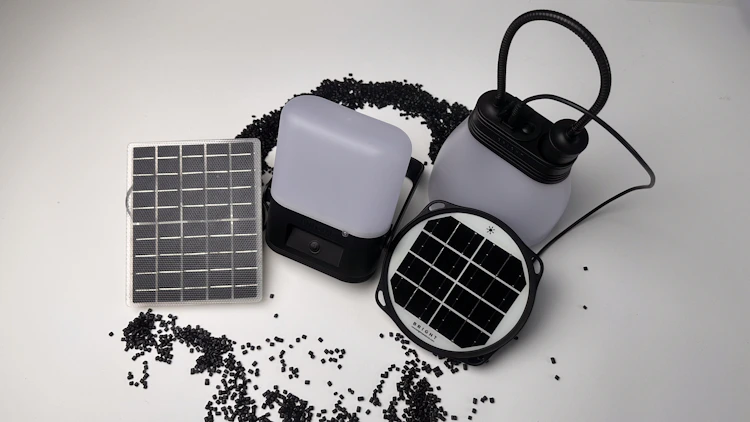Why producer engagement is important for solving the e-waste challenge in displacement settings: Lessons from Cox’s Bazar
Solar lamp producers who supply humanitarian organisations in displacement settings have a critical role in supporting organisations managing electronic waste (e-waste). Explore how BRIGHT’s Repair Program supported impactful repair initiatives in Cox’s Bazar Kutupalong settlement.
All articles
-
![Repair trainees learn how to fix solar lamp PCBs as part of BRIGHT’s humanitarian e-waste programme.]()
- Sustainability
- Field work
- Humanitarian
- Repair
- Insights
Why producer engagement is important for solving the e-waste challenge in displacement settings: Lessons from Cox’s Bazar
Solar lamp producers who supply humanitarian organisations in displacement settings have a critical role in supporting organisations managing electronic waste (e-waste). Explore how BRIGHT’s Repair Program supported impactful repair initiatives in Cox’s Bazar Kutupalong settlement.
Read more
-
![Joona Cichy sits next to some of the SunTurtle solar lamps he bought for donation to learners in Ghana and Madagascar through his Bright Futures ngo]()
- Stories
- Humanitarian
Bright Futures: How a 16-year-old is donating solar lamps to help learners study after dark
In Cologne, Germany, December darkness settles early. Most students move from school to after-school clubs and switch on their desk lamps without a second thought. Yet for millions of children elsewhere, nightfall closes the school day altogether. This contrast prompted one student to act.
Read more
-
![BRIGHT Products was one of the top 5 finalists in the inaugural UNIDO ONE World Sustainability Awards' Women in Industry category]()
- News
BRIGHT honoured as global finalist at inaugural UNIDO ONE World Sustainability Awards
BRIGHT has been recognised by the United Nations Industrial Development Organization (UNIDO) as one of the five global nominees in the Women in Industry category of the inaugural UNIDO ONE World Sustainability Awards. The nomination places BRIGHT among a select group of organisations shaping more inclusive and sustainable industrial practices.
Read more
-
![]()
- Sustainability
- News
BRIGHT publishes Environmental Product Declarations for SunBell 2.0, Sol Mid Capacity solar lamps
As part of our commitment to sustainability, BRIGHT is proud to announce the publication of the Environmental Product Declarations (EPDs) for our SunBell 2.0 and Sol Mid Capacity solar lamps. These EPDs provide customers, procurement officers, and partners with independently verified data on the environmental footprint of our products.
Read more
-
![]()
Delivering light anywhere: How BRIGHT’s humanitarian logistics enable global reach
BRIGHT has delivered over 4.3 million pico-solar products to more than 60 countries, reaching communities in crisis zones, refugee camps, and remote off-grid areas. Behind this achievement is an innovative humanitarian logistics system that combines data-driven planning, sustainable packaging, and trusted global partnerships. With hubs in China and Norway, BRIGHT ensures solar lamps and energy solutions reach those who need them most – quickly, reliably and responsibly.
Read more
-
![BRIGHT solar lamp Repair Program in Bidibidi Uganda. Group photo of E-waste Management project participants, featuring representatives from BRIGHT and IOM (© BRIGHT).]()
- Stories
- Sustainability
- Field work
- Humanitarian
BRIGHT’s solar lamp Repair Program: Partnering on the leading e-waste management project in the humanitarian sector
In Uganda’s Bidibidi refugee settlement, the International Organization for Migration (IOM) is leading several partners in pioneering the most comprehensive electronic waste (e-waste) management project in the humanitarian sector. At the heart of this project is BRIGHT’s solar lamp Repair Program which is training technicians who are turning e-waste into opportunity through the repair and refurbishment of solar lamps. These technicians have since the launch of the E-waste Management project in 2022 repaired 6,361 solar lamps and 341 solar panels, reduced e-waste, and significantly improved their livelihoods. By embracing a circular economy, improving product design, and centering community voices, BRIGHT’s Repair Program offers a sustainable model for handling e-waste in displacement settings, aligning with Sustainable Development Goals 7 (Affordable and Clean Energy) and 12 (Responsible Consumption and Production).
Read more
-
![Image of the upgraded SunBell 2.0Y solar panel made with 100% post-consumer recycled (PCR) plastic and the Sol solar lamp with the new, lighter and more efficient monocrystalline solar panel using Ethylene Tetrafluoroethylene (ETFE) plastic. Two latest innovations showcasing BRIGHT's approach to using circular product design to tackkle plastic pollution]()
- Insights
Tackling plastic pollution through circular product design, BRIGHT’s approach
The United Nations Environment Programme (UNEP) estimates that globally more than 400 million tonnes of plastic is produced annually. Half is used once and discarded, with less than 10% recycled. Around 11 million tonnes end up in water bodies annually, imposing a global environmental and social cost of between US$300 billion to US$600 billion.
Read more
-
- Insights
How to choose the best solar lamp for emergencies
Power outages are a predictable feature of modern crises. Storms, floods and grid failures often cut electricity when it is needed most. For governments, aid agencies and households, a dependable solar lamp has become an essential part of emergency preparedness. The right lamp can provide safety, light critical spaces and keep basic communication running when the power goes out.
Read more








